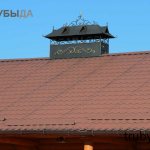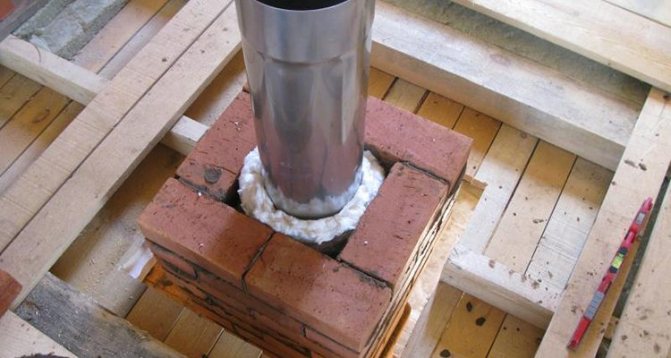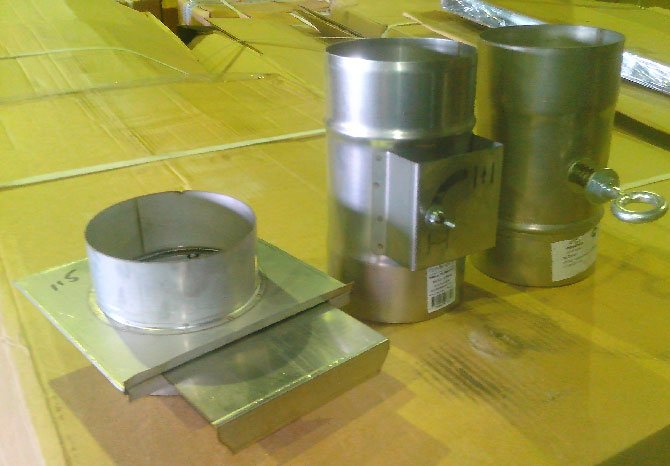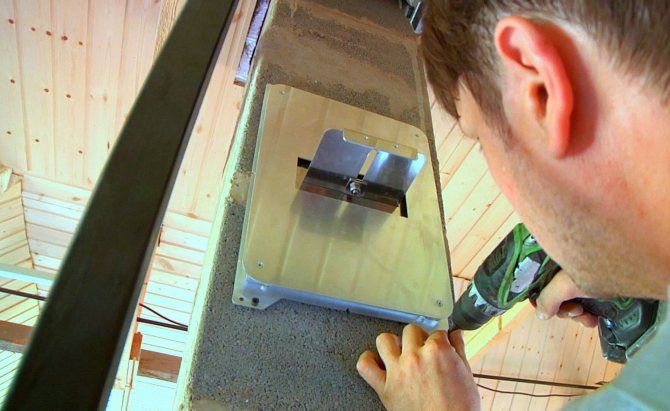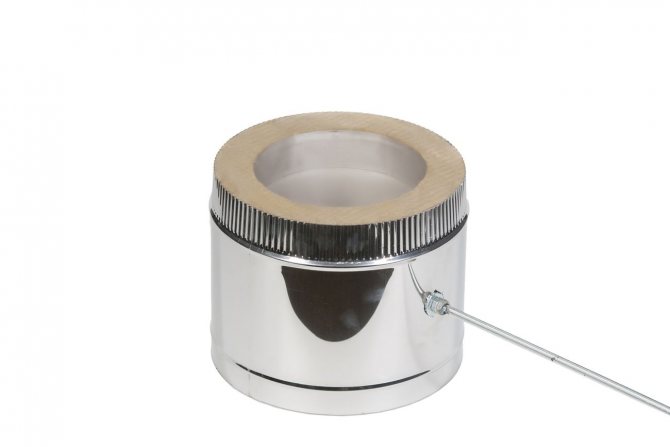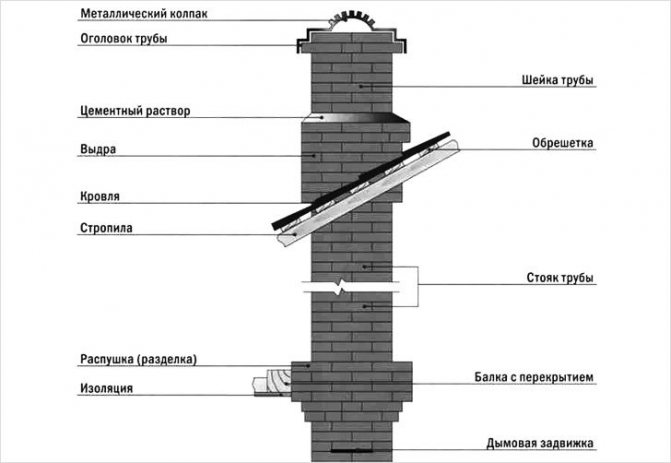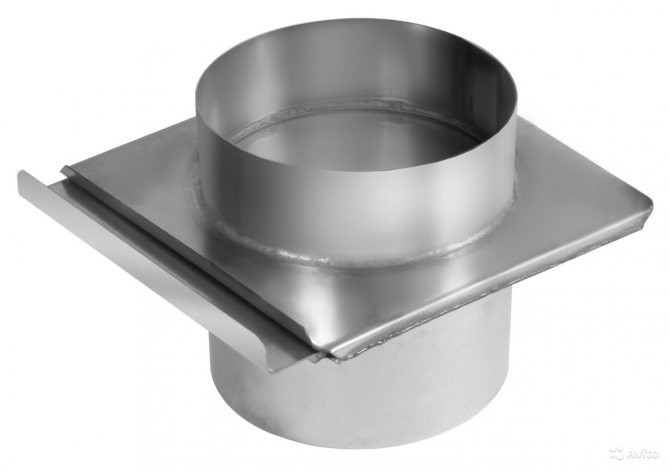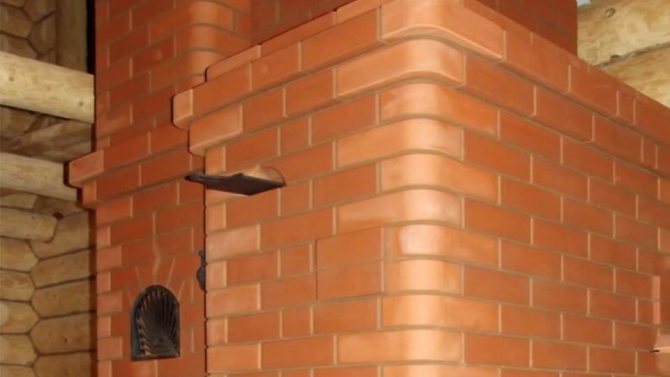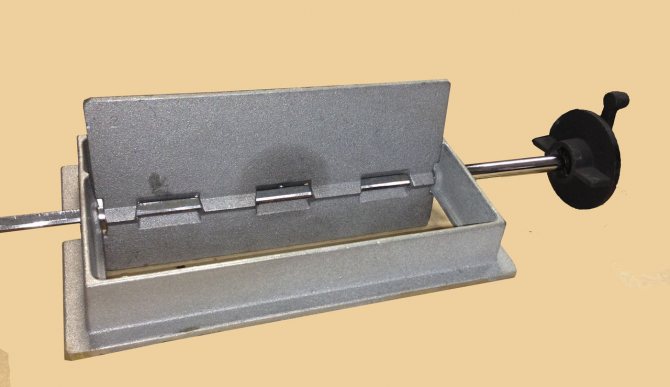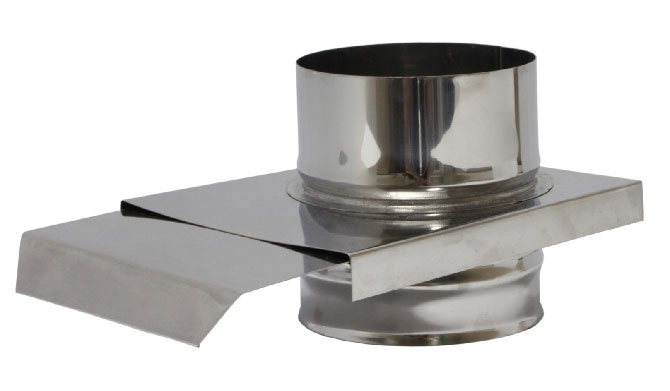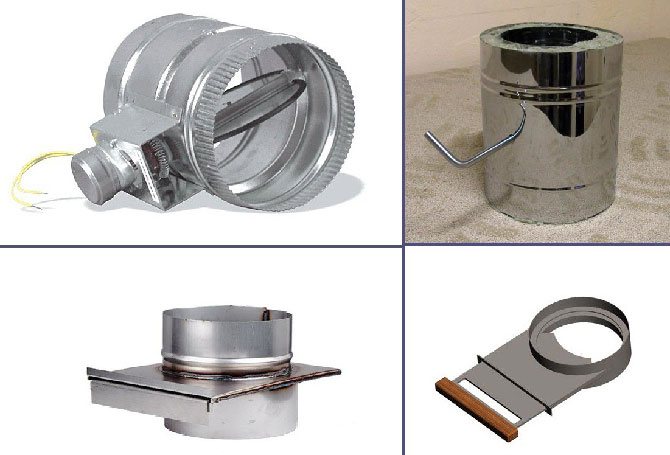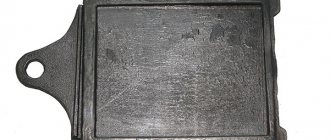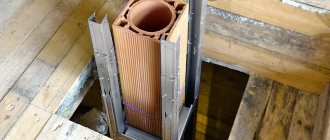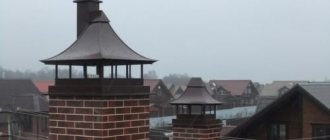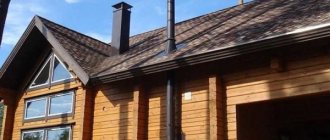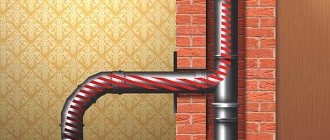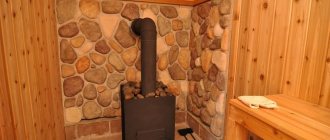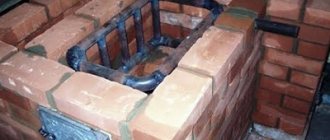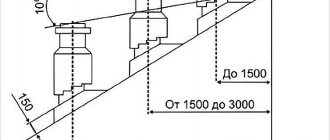To regulate the intensity of combustion and the discharge of exhaust gases through the furnace heating pipe, a chimney damper is used. The part is a mechanical damper - a device that blocks the internal passage in the chimney. A small device saves up to a quarter of fuel in the firebox of a boiler or stove. It is used in the smoke evacuation system and ventilation ducts.
Chimney
Functions, purpose and characteristics
A gate is a partition that is located inside the chimney. It repeats the shape and area of its cross-section and, when closed, almost completely overlaps it. Changing the position of the gate allows you to increase or decrease the opening of the chimney pipe, increasing or weakening the air flow. With the help of the damper, you can stop air movement after lighting the stove.
The slide gate is a thin metal plate that is manually adjusted using a special knob. The latter is located outside the chimney pipe so that the user can manually adjust the position of the plate.
Depending on the design and type of the damper, it is installed using a special metal frame, or inserted into the pipe and fixed with an axial rod.
The chimney damper performs the following functions:
- increases traction in difficult weather conditions;
- increases the intensity of combustion in the furnace by increasing the flow of oxygen;
- reduces traction when there is a strong hum in the chimney during strong winds;
- saves fuel by reducing combustion intensity;
- prevents heat leakage after the heater has warmed up.
Gate design and its purpose
A chimney damper is a special damper that regulates the draft in modern chimneys. They are required for variants of single-walled and double-walled boilers. Thanks to its presence, the efficiency of the functioning of the heating system as a whole increases significantly.
Rotary vane damper drawing
The purpose of the gate is as follows:
- Regulator damper for partial blocking of the chimney.
- Regulation of the combustion process in the fireplace insert.
- Chimney draft adjustment.
After the firebox, it is necessary to close the smoke channel by means of a gate valve. While the oven is not in use, it remains closed. It also allows you to adjust the position of the damper depending on the characteristics of the traction.
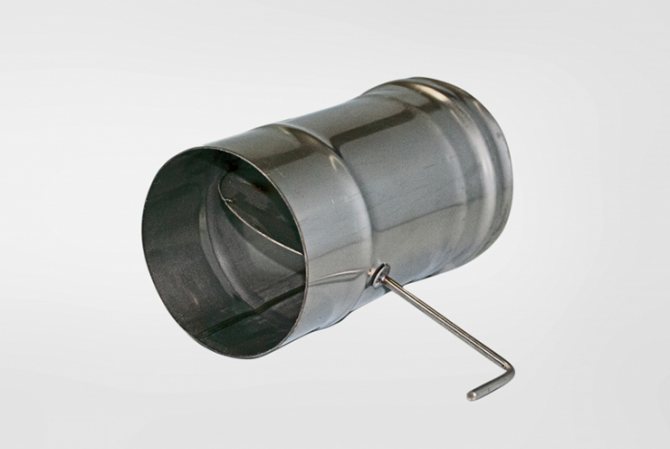
There is no need for the presence of a gate if combustion is ensured by supplying supply air masses.
Features of the installation of slide dampers
Structurally, the gate is a locking device with an adjustable gate valve. It is thanks to the displacement of the valve that the movement of gases in the chimney is regulated. It can be installed in round, square and rectangular chimneys. It is a metal plate that moves inside the smoke channel in a certain way.
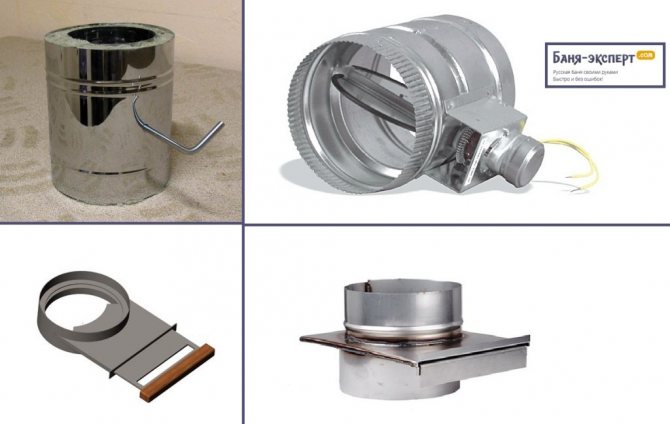

Gate dampers can be of two types:
- Retractable. Moves back and forth in the same plane.
- Swivel. Regulates air access by turning around its axis.
In addition, the gate valves can be manual and equipped with an electric actuator. The cost of the latter is an order of magnitude higher and they are not used in chimneys.
To install the throttle valve, it is necessary to make markings on the pipe in order to drill holes according to the welded valve structure.
To do this, you need to measure the pipe with a measuring tape and make marks for future holes.After making sure that the marks are symmetrical, drill holes for the future rotary handle with a drill.
The installation of the throttle gate is as follows:
- A steel damper circle with a welded tube is inserted into the chimney pipe.
- A metal rod is threaded through the drilled holes in the pipe through a small tube, the end of which is fixed with a bolt and nut.
- The end of the rod is folded back with the rotary handle pliers.
Next, you can install the resulting structure in the chimney pipe. For this, the first piece of pipe is put on the nozzle of the furnace heating furnace, on which a structure with a slide damper is installed on top. The next piece of metal pipe is put on the gate. All joints are sealed with liquid silicone sealant.
The installation of a retractable gate in a brick chimney occurs during the masonry process. To do this, after 6-8 rows of bricks, a layer of cement masonry mortar is applied, on which the wire frame is installed with the open side to the performer. The latch must be inserted into the frame and brought into a closed state.
From above, the frame is covered with mortar and the brick continues to lay out according to the standard scheme.
- Horizontal retractable gate. The plate inside the gate extends, due to which the chimney cross-sectional area is adjusted. Typically, this type of valve is used for installation in brick chimneys. Often, small holes are made on the surface of the plate so that even in the closed position of the gate, it does not 100% block the smoke channel. This complies with fire safety regulations. The advantage of this type of device is the ease of installation.
- Rotary gate. It is also called a “choke valve”, which is a metal plate attached to a rotating shaft. The axle, in turn, is mounted inside the chimney pipe. This device has a removable rotary disc, but with prolonged use it may become unusable. However, the scheme of the rotary mechanism allows you to repair and replace it yourself. The advantage of this type of device is its ease of use. This type of gate does not require constant monitoring by the owner of the house.
Due to the complexity of the design with your own hands, the rotary mechanism is less often used when laying a fireplace or stove.
The gate design is necessary for wood stoves and heating devices operating on any solid fuel.
Therefore, for a gas boiler, the most practical solution would be to install a rotary mechanism. The temperature of the exhaust gases is less low than when working with solid fuel, therefore, the operation of such a mechanism will be most convenient.
Valve on the insulated chimney
But it is better to refuse to install the rotary mechanism in the bath. The fact is that it will partially let steam through in a closed form. And when open, such a mechanism is difficult to clean.
Made of stainless steel, the slide mechanism will not completely cover the chimney, but at the same time will exclude the possibility of pulling out tongues of flame through the ash pan into the room.
There are three options for installing the gate.
- Installing a damper in a fireplace insert. For this, the gate is mounted at a distance of 1 meter from the heating device, which ensures simple operation.
- The "pipe-to-pipe" option involves combining the gate with other elements of the heating structure without the additional use of fasteners.
- Installation of a gate valve in a ventilation pipe. But this option is usually used to protect the fan motor from overheating during operation.
We suggest that you familiarize yourself with Cadastral registration of a bath
But even if the finished kit goes without this element, the gate can be easily made with your own hands, choosing the most optimal version of the mechanism for yourself.
Like any engineering solution, the gate has a number of advantages and disadvantages.
Pros:
- Possibility of traction control;
- Fuel economy;
- The dampers help to retain heat.
Minuses:
- Devices make it difficult to clean chimneys;
- If installed incorrectly, the gate can wedge and adversely affect the movement of gases;
- For correct adjustment, it is necessary to have a certain knowledge in the field of flue systems.
The retractable damper allows you to adjust the working section of the chimney, the rotary damper only opens or closes the pipe. Of course, some tricks are possible - such as fixing the hog in an intermediate position in different ways, but the factory equipment does not provide for this. In addition, the rotary gate complicates the mechanical cleaning of the pipe.
How to make a chimney gate with your own hands
It is better to make and install the gate yourself in the process of laying a fireplace or installing a metal chimney.
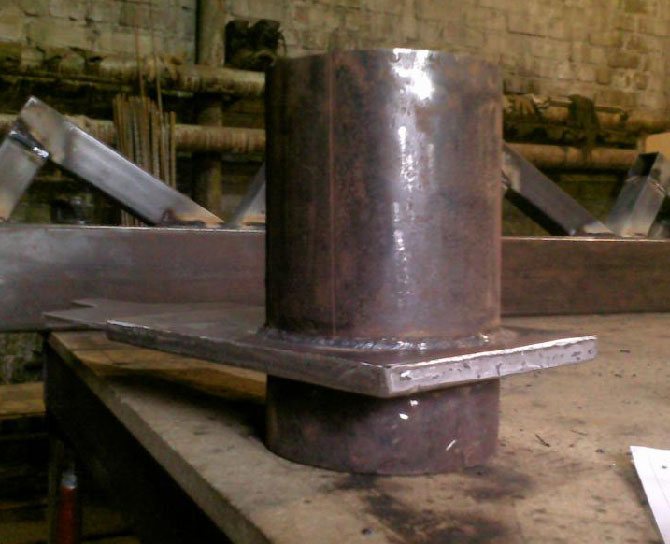

You can also make and install it if the steel chimney is already installed, but the damper was not provided in it. Depending on the diameter and cross-sectional shape of the chimney, the material of execution, it is possible to make a retractable and butterfly valve.
Note! For a brick chimney, a retractable rectangular damper on a special groove is better suited. For a metal pipe, you can choose any option.
Instruction for the manufacture of a retractable gate
For the manufacture of a simple sliding damper, galvanized or stainless steel sheets with a thickness of 2-2.5 mm are required. Making guides around the chimney perimeter will require 6 mm thick wire.
We recommend that you familiarize yourself with: How to choose drainage pipes with perforation when arranging drainage systems
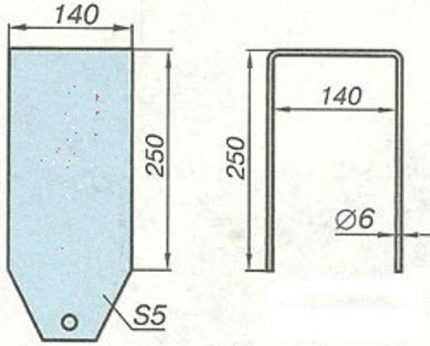

To complete the work you need equipment and tools:
- grinder or scissors for metal;
- grinding disc for angle grinders;
- drills and files for metal;
- marker for marking.
It is advisable to do all the work on a special lathe or benchtop machine. If the shape of the chimney is rectangular, you can make the simplest slide damper by simply cutting off a piece of sheet steel of the required size. It is recommended to weld the handle or drill a small hole for ease of gate adjustment.
Before starting work, we measure the area and shape of the section of the chimney, with a marker we make marks on a sheet of cardboard in accordance with them. For the manufacture of the frame, we bend the wire in the shape of the letter P, in width and length that coincides with the section of the chimney. We cut out the flap according to the cardboard pattern with a grinder, we process the edges with a grinding disc.
Important! The width of the wire frame should be 2-3 mm larger than the gate plate so that the damper moves freely and does not get stuck during the thermal expansion of the metal.
Throttle gate manufacturing instructions
It will take more tools and time to make a rotary gate valve. Most often, this type of gate is used for a metal chimney for modern fireplaces and metal freestanding stoves.
A set of tools for work:
- Bulgarian;
- drill;
- pliers;
- welding machine;
- compass;
- roulette;
- marker for marking.
To make a gate, you need sheet steel up to 3 mm thick, a stainless pipe with an inner diameter of 6 mm, fasteners (bolts, nuts) 8 mm, and a metal rod.
- First measure the inside diameter of the flue pipe with a compass.
- According to him, draw a circle on sheet steel.
- Cut a circle with a grinder.
- Place the cut fragment in the pipe and check the tightness. If necessary, rework the shutter with a grinding disc.
- Put a metal tube with a diameter of 6 cm on the circle in the center and make marks on it, stepping back 3 mm from each side of the circle.
- Cut off the pipe with a grinder.
- In the obtained pipe section, drill the threads up to 6.8 mm on both sides.
- Drill holes for welding in the steel circle (one - in the center, two - 1 cm from the edge on opposite sides).
- Weld the threaded pipe to the steel circle.
We recommend that you familiarize yourself with: How to eliminate a fistula in a metal or plastic pipe
The gate valve is ready, it remains to install it in the chimney pipe.
The main types of gate valves
Being the main regulator of the draft inside the chimney, the damper regulates the combustion of the fuel. To reduce the thrust and reduce the intensity of the flame in the firebox, it is enough to cover the gate valve. To increase the thrust, on the contrary, it is necessary to open it.
In fact, a gate is a regular metal plate that allows you to adjust the thrust.
It can be installed both in single-wall boiler systems and in double-wall boiler systems.
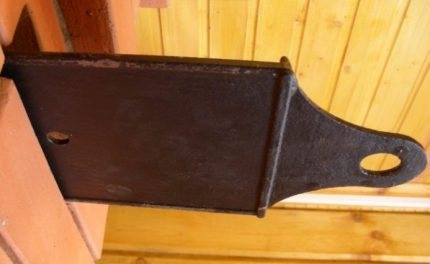

If the fireplace with the stove is not used, then during this period the gate valve must be in the closed position.
As a rule, the valve is installed at the initial section of the chimney (on the first meter), since this particular section remains not insulated.
But on the section of a well-insulated chimney, on the contrary, it is not recommended to install a valve. Especially when it comes to double-circuit pipes. When the metal of the inner and outer pipe expands, the gate valve can jam.
So, the main tasks of the gate valve are:
- Chimney draft regulator function.
- Partial overlap of the chimney section.
- Regulator of the intensity of combustion of the flame in the furnace.
Today there are two main ways to install a gate on a chimney:
- Installation in a fireplace insert. This installation option implies the location of the gate product in the immediate vicinity of the heating equipment. As a rule, in this case, the distance from the gate to the heater is 1 meter. This arrangement is very convenient for regulating the valve.
- Connection with other elements of the heating system. In this case, there is no need to use additional fixing elements, so this option is quite common. Such installation can also be called "pipe to pipe".
The above options for the use of valves for chimneys and ventilation systems are used everywhere. It is worth noting that today you can find a huge variety of stoves and fireplaces that differ from each other from a constructive point of view. Such a variety of heating devices also influenced the range of slide dampers.
- Installation of a valve in an insulated area. Thermal expansion can cause the damper to jam;
- Installing a cast iron part in a metal chimney (cast iron weighs a lot);
- Using too thin steel or stainless steel with a low nickel content for the manufacture of the valve. Such a product quickly deforms under the influence of hot gases and can burn out;
- Installation of a gate with an uneven surface;
- Installation of a valve without a hole for the release of carbon monoxide;
- Installation of handles that do not allow tracking the position of the valve (applies to rotary elements).
Types of gates
Modern experts have developed several types of gates, which have a number of significant differences from each other. First of all, they relate to the design features of the models.
The most widespread are the following types:
- retractable;
- swivel;
- cast iron;
- steel.
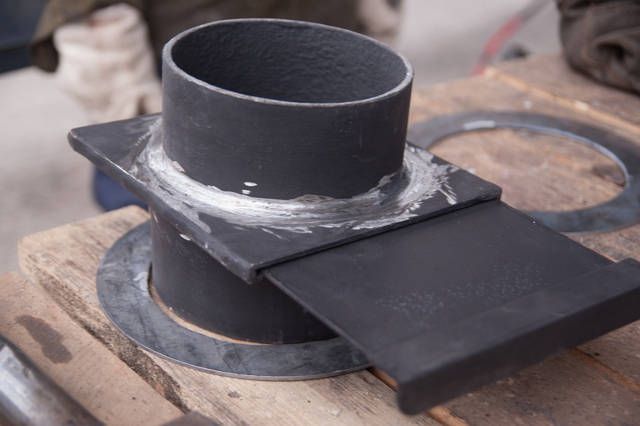

The most popular is the slide-type chimney damper. It compares favorably with other types of reliability in operation with ease of use.The retractable gate is a plate with a smooth, even surface, in which there is a special longitudinal hole. It runs along the grooves in the chimney.
This type of valve is installed strictly horizontally. To change the draft force in the chimney, it is enough to move the damper in the desired direction, increasing or, conversely, reducing the section for the pipe.
This option is suitable for steel pipes, but is more suitable for brick ovens. To install it, no special knowledge or significant effort is required.
Some models have a small cut-out area. This ensures the safety of the structure: even if this valve is completely closed, the movement of carbon monoxide in it will continue.
We offer you to familiarize yourself with: Grinding a log house with your own hands - an overview of tools and technology
Another type is a rotary gate. It is a plate made of metal, which is fixed in the central part of the guide by welding.
Dimensions and principle of operation of the rotary gate
Its main share is located in the inside of the chimney, but the tip should always remain outside. Against the background of the rotation of this plate relative to its own axis, the draft in the chimney is regulated.
The disadvantage of this type is the need for fastening by welding. It is this place that is the weak point of the structure: the damper will open if the mount relaxes.
The rotary gate is not very reliable. But this figure can vary depending on what it was made from. Most often it is used for installation in steel chimneys. And also it is installed in cases where there is not enough space to extend the classic valve.
The cast iron gate is widely used in various types of stoves and fireplaces. The disadvantage of such products is their significant mass. At the same time, cast iron itself has been used for a long time in the production of valves for furnaces. This is explained by its high reliability, durability and strength.
Model range of cast iron gates
A stainless steel gate assembly is not the cheapest option. But the design is characterized by high quality and excellent performance. Its advantages are as follows:
- maintaining the efficiency of the furnace;
- small weight;
- long service life;
- not subject to metal corrosion;
- prevents the accumulation of soot.
These gates can have a different design depending on the characteristics of the furnace. They are relevant for chimneys made of steel or brick.
Tips for choosing a gate valve
It must be remembered that the correct selection of such an element as a gate damper will affect in the future not only the draft indicator, but also the safety of the heating system, of which the chimney is a part. Installation of the gate is carried out on any model of fireplaces and stoves, except for the most modern ones, in which there is a deflector.
The main recommendations for the selection of slide gates for flue gas communication are as follows:
- if the heating device operates due to gas processing, it is better to purchase a rotary valve model. This is due to the fact that such models exclude the possibility of complete blocking of the chimney duct. Thus, the heating system will be safer. The chimney that removes the combustion products from the gas stove must be closed by at least 40 percent during operation;
- there are heating systems that do not function permanently (periodic). A closed damper installed in such a heating structure, as a rule, allows steam to pass through during delivery, and an open damper contributes to the formation of a large amount of soot on the pipe, which is located below the plate;
- It is strongly discouraged to use rotary elements for installation in sauna chimneys.
A rotary device is the most suitable option for a system that consumes gas
Experts recommend making a careful measurement of the cross-section of the chimney duct before purchasing a gate product. Perhaps this is the main thing that must be done before purchasing a gate.
We offer you to familiarize yourself with the BBQ area with a sauna and a gazebo
There are 3 options for the location of the damper in relation to the chimney:
- Placement in the firebox of a fireplace or stove;
- Pipe-to-pipe fastening;
- Installation in a ventilation pipe.
Consider the first 2 options:
- Placing the valve in the furnace of the furnace, or in the outlet
In this case, the damper is located at a height of no more than 1 m from the firebox, on a non-insulated section of the pipe. This location is convenient for adjusting the damper.
Applicable for metal chimneys. This installation option does not require additional fasteners. When purchasing a ready-made system, the valve should be installed strictly according to the manufacturer's instructions.
Adjusting thrust with a gate is quite simple. By changing the position in the direction of increasing the gap, we increase the flow of air to the fire and the flame flares up more strongly. We reduce the clearance - the thrust is reduced. The shutter is closed after the flame has completely extinguished - this way the furnace cools down much faster.
Choosing a location option
There are several ways to install a gate, each of which has both pros and cons. An important factor is what the chimney is made of. But modern craftsmen prefer to use the three most common options:
- Installation in a fireplace insert.
- Pipe-in-pipe fastening.
- Installation in a ventilation system.
If you install a gate in the furnace of the stove itself or at the outlet pipe, then the damper will be located on that section of the pipe that is as close as possible to the heating boiler. It should be noted that in this case the valve will be built into the main structure of the chimney. This method has its advantages, as the valve will be easier to use. This is due to the fact that the gate handle will not touch either the cladding area or the portal itself.
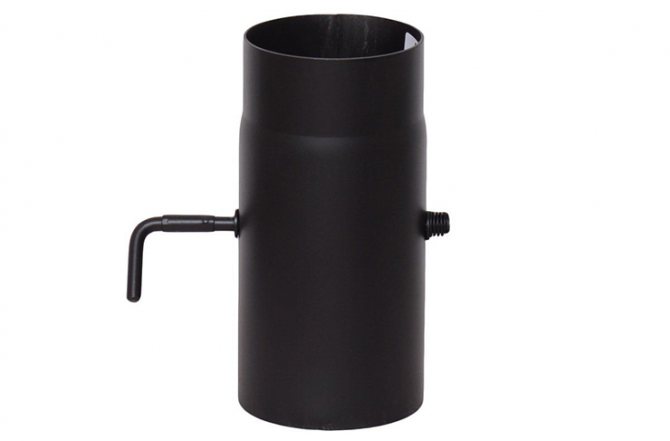

The gate can be installed in the ventilation system
In the event that the master has chosen the type of installation "pipe-to-pipe", then he will not need to use special fasteners to securely fix the damper with the elements of the fireplace. The location of the gate in the ventilation system completely eliminates the possibility of overheating of the fan motor during active operation.
Modern manufacturers offer chimneys ready for installation, which are equipped with all the necessary devices (a gate damper is no exception). In this case, the part must be used in strict accordance with the recommendations established by the manufacturer himself. Otherwise, you can make a valve in the chimney with your own hands and at a more affordable price.
We suggest you familiarize yourself with: Sheathe the front door with wood
There are three main options for placing a gate in a chimney:
- pipe-to-pipe mount;
- placement in a fireplace insert;
- installation in a ventilation pipe.
Brick chimney with slide damper
If you place a gate valve in the outlet pipe or in the furnace of the furnace, that is, integrate this element into its structure, the damper is placed on the pipe section as close as possible to the heating boiler. This guarantees ease of control, ease of turning the damper. This is explained by the fact that the handle will not touch either the portal or the cladding area. If it is located according to the pipe-to-pipe option, no additional fasteners are required to connect with other elements of the furnace.
If the vane assembly is located in a pipe intended for ventilation, overheating of the fan motor during its operation is excluded.
Usually, chimneys are offered ready-to-install, which are equipped with everything you need, including a gate valve. In this case, it is placed in the system in accordance with the manufacturer's instructions. If it is not provided for one reason or another, it is quite possible to make and install this element yourself.
Shiber varieties
Retractable
Sliding gate
The sliding gate is considered to be the most convenient and reliable to use. It is a smooth plate with a small longitudinal hole moving along the grooves in the chimney. It is mounted in a horizontal position, the traction force is regulated by the movement of the plate, which decreases or increases the cross-section of the pipe. This type of valve is intended for brick ovens, although it can also be used in chimneys made of steel pipes.
Gate with plate
Rotary gate. The plate is visible, which regulates traction
The swivel gate is a metal plate with a guide welded in the center. Installed inside the chimney, while the end of the guide must be brought out. The thrust is adjusted by rotating the plate around its axis. This design is less reliable, as over time the welding fixture looses and the flap comes off. The rotary gate is used in steel chimneys.
No less important is the material from which the valves are made.
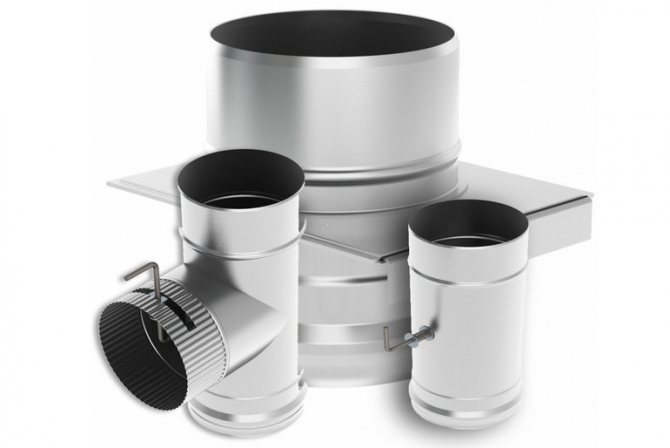

Cast iron gates
Cast iron is a very strong and durable material traditionally used for the manufacture of stove valves. The cast iron gate has only one drawback - a lot of weight.
Cast iron gate for sauna stoves, fireplaces
Cast iron gate
Stainless steel
High quality steel gate assembly
Stainless steel is not afraid of corrosion, lasts a long time, weighs little and does not reduce the efficiency of the furnace. The smooth, polished surface of the stainless steel slide prevents soot build-up for easy cleaning. Such gates can be of any design and can be installed in both brick and steel chimneys.
Steel gate in a brick oven
How is the gate structured?
The design of the device consists of a frame with a moving plate, the displacement of which helps to regulate the movement of gases and the intensity of the combustion process. The retractable chimney damper is installed in square, oval and round pipes.
The damper design can be of the throttle or rotary type. The guide piece is attached by welding in the center of the plate, its end is brought out beyond the walls of the pipe to the outside. With its help, the thrust is adjusted by turning the plate inside the device. The reliability of this type is lower than the retractable version, since over time the fastening weakens and the plate does not hold in the desired position. The gate type is recommended for a metal chimney.
Installation features
- When installing the gate at the stage of bricklaying, the frame is placed at a height of 6-8 rows from the base of the pipe;
- The frame should be level without overlapping the chimney contour;
- In stainless chimneys, the valve is mounted using pipe-to-pipe technology. It is necessary to match its dimensions with the channel diameter;
- An important nuance - the damper is installed on a non-insulated section of the chimney;
- The height from the firebox to the gate should not exceed 1m (for metal ducts);
- The height of the pipe from the floor to the valve is -1.8-maximum 2m (for brick);
- The damper in the grooves must move freely;
Retractable gate design
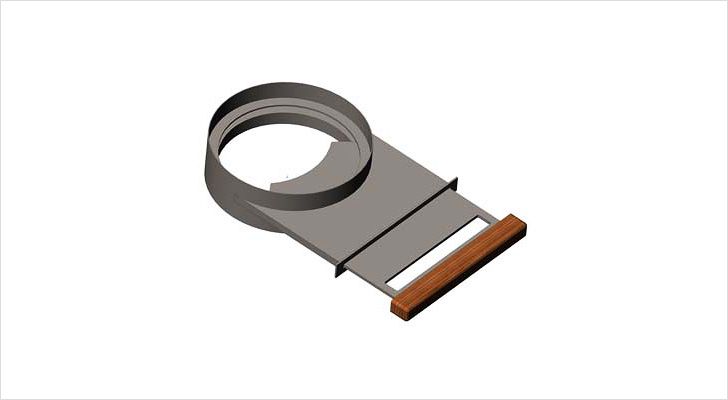

Gate valve design
A gate is a metal damper installed to completely or partially block the smoke channel. Its installation allows you to change the draft and the intensity of fuel combustion. For the manufacture of the part, heat-resistant stainless steel is used. The thickness of its walls is 0.5–1 mm. In brick chimneys, the option of using a cast iron valve is possible.It has many advantages: strength, long service life, chemical resistance.
Note! The main disadvantage of a cast iron gate is its significant weight, so the part is not intended for metal pipes.
The damper is designed for operating temperatures up to 900ºC. It is installed near the combustion chamber on the first meter of the chimney. This place must not be insulated so as not to jam the damper. After the cessation of the combustion process, it is completely closed so that the heat does not go out into the street.
Features of the gate service
A gate made of stainless steel sheet is usually polished to a perfect smoothness. Soot settles badly on it, but still settles. Therefore, it needs to be cleaned periodically.
The horizontal valve can be cleaned simply by pulling it to the maximum and applying a special solution. Swivel - cleaned through the chimney with a special plastic brush. You should also monitor the free movement of the damper along the guides. It is allowed to periodically lubricate them with an anti-corrosion compound.
Gate specifications
For the manufacture of gate valves for stoves and fireplaces, stainless steel is most often used - steel, the least susceptible to corrosive processes. The metal should be one millimeter thick.
The surface of the part is sanded to an absolute smoothness, which is free from defects, so that it can be easily cleaned of deposits of dirt and soot that accumulate over time. This circumstance contributes to the appearance of good draft in the chimney pipe, since there is no resistance to the exit of gas particles.
Types and designs
The slide device is influenced by various factors: temperature, pipe dimensions, flow conditions. The construction is based on a sheet of metal of different thickness, moving along the slotted pocket, guiding corners.
Depending on the base, the gates are shut-off, throw-over. They serve to restrict the movement of air flows.
There is a classification of devices according to the principle of operation, depending on the type of drive: manual, pneumatic, hydraulic, electric. Gates are available with straight and oblique designs. The first option is a classic damper. Designed for forced-air supply and exhaust ventilation systems.
The chimney damper is available in several versions.
Retractable


Represents a round or rectangular frame with a plate. The plate extends and retracts, thereby adjusting the cross section of the chimney.
This option is most often used with brick and ceramic ducts. For incomplete sealing and to avoid carbon monoxide poisoning, a small hole is made in the plate. The main advantage of this option is ease of installation.
A rotary, or throttle, damper (aka hog) is a plate of steel or cast iron rotating around an axis. Axle - a metal rod welded inside the chimney. Used in steel chimneys.
We suggest that you familiarize yourself with How to make a ceiling in a steam room with your own hands, what is the permissible ceiling height in a sauna, features of the insulation of the structure, a detailed photo and video
It differs in less reliability - over time, the welding fastening of the plate and axis weakens. You should refuse to install a rotary damper in the bath - even in a closed form, this type of damper partially lets in steam.
In addition, the gates differ in material (the most common are stainless and cast iron) and in the way they are adjusted.
Features of gate structures.
Gates, or gate valves (dampers, gates), are of two types and are made of different materials.
- Retractable.The main structural element of the structure is a sheet of metal moving inside the slotted pocket, due to the horizontal movement of which the cross-section of the chimney is reduced or increased.
- Turning. The adjusting plate in such a valve design rotates around its axis and is attached in the middle to the guide. By rotating the damper in the pipeline, you can regulate the amount of smoke passing through the structure, and accordingly influence the draft, decreasing or increasing the gap between the gate plate and the chimney.
The rotary damper for the chimney is less in demand, due to the imperfection of the design. Exposing a fixed plate to high temperatures can, over time, weaken its attachment points on the pivot shaft. Valves of this type are made of stainless steel, since it is quite lightweight and perfectly resists corrosion.
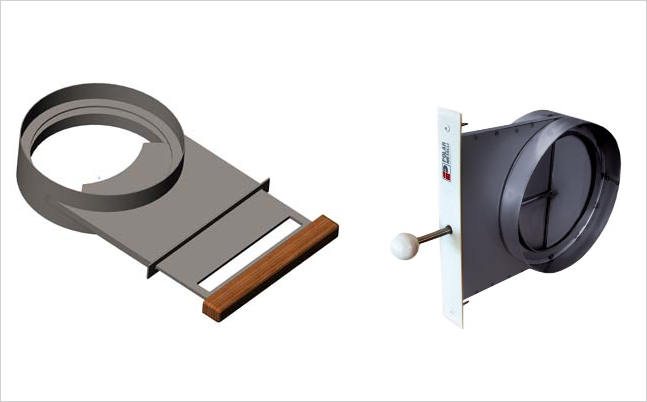

Sliding dampers are found, made of cast iron and stainless steel. Cast iron is heavier and when installing this device in a chimney, difficulties often arise. Most often, cast iron butterfly valves are installed in brick chimney systems. The stainless steel gate is lighter and therefore perfect for any chimney.
What does the gate give
Just like traditional chimney dampers, the gate allows you to open or close the access to the chimney for combustion products. In addition, it performs several more useful functions:
- Regulates traction.
- Reduces fuel consumption.
In older ovens, the gate was usually not installed. If you want to make stove heating more efficient, you should install this simple device. Modern furnaces, as a rule, already have a flange with a gate in the kit, but it can be purchased separately. The simplest gate can be made with your own hands.
Before buying or constructing a chimney damper with your own hands, it is worth understanding the principle of its operation. During the heating of the furnace, the valve partially overlaps the cross-section of the pipe, allowing the flue gases to escape through the pipe and, at the same time, regulates the thrust force. After stopping the furnace, by completely closing the damper for the chimney, the exit of gases stops. Traction control simultaneously allows you to control and change the intensity and speed of fuel combustion. In modern heating devices, the gate must be installed in boilers.
The gate differs from the traditional gate valve in several parameters:
- Resistant to high temperatures (withstands heating up to +900 degrees).
- Corrosion resistant.
- The ability to block the chimney during the heating up to 85% of its cross section.
- Good thermal conductivity.
Principle of operation
The valve performs the function of adjusting the draft - it closes or opens the chimney duct, which allows you to keep heat in the room for a long time. After the firebox, the valve is closed completely, which is not dangerous, since there is a safety gap on the devices so that carbon monoxide does not collect inside the room.
In case of excessive draft, the valve should be slightly closed, allowing the walls to warm up due to the change in the intensity of combustion and the delay of heated smoke in the channel. Thus, it will also be possible to save fuel and at the same time maintain a favorable temperature in the house. When there is smoke or the smell of carbon monoxide is felt in the room, then the entire smoke system should be examined, including the gate, which most often in such cases has a soot deposit.
Creation of a rotary gate
First, we will learn how to make the most difficult version of the gate. Detailed instructions will help you get the job done quickly. We will learn how to make a valve when the stove heating has already been done, however, the gate was not provided in it.
To make a gate, you will need the following tools:
- electric drill;
- grinder with a circle for metal;
- tap, which is needed to cut an internal thread in a hole;
- oil to lubricate the tap when forming the thread;
- a hammer;
- welding machine and electrodes for working with stainless steel;
- vice;
- pliers;
- compass and tape measure;
- core;
- permanent marker.
The list of materials for creating a gate valve is as follows:
- stainless steel sheet, the thickness of which is from 1.5 to 2 mm;
- a stainless steel tube, the inner diameter of which is 6 mm;
- 2 bolts, 8 mm in diameter;
- a weaving nail or a metal rod.
If you have everything you need, you can start working on creating a gate:
- First you need to measure the inner diameter of the chimney. Record these indicators. After that, a steep of such a diameter is outlined on a stainless steel sheet, only 1–2 mm less so that the plate can rotate freely.

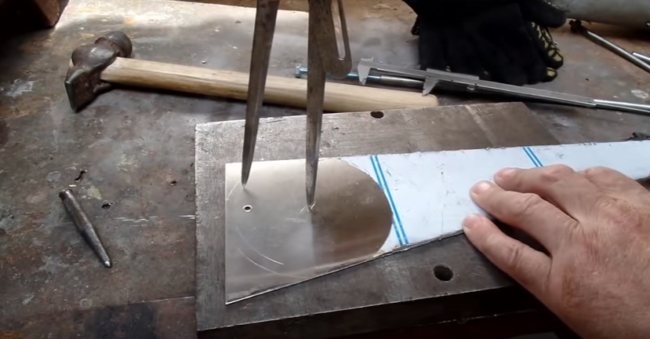
- After that, this intended circle is cut out with a grinder. You need to do everything carefully so that the edges are even.

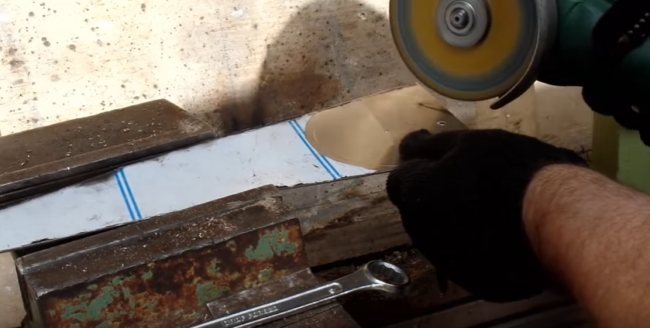
- The cut-out valve should fit perfectly into the chimney. To do this, you need to try it on. If necessary, the plate is protected, polished and brought to the desired size.

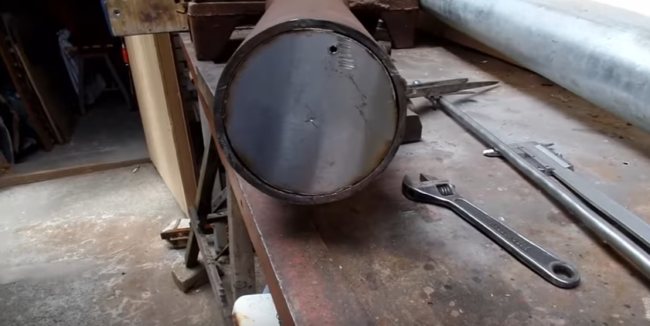
- Now you need to take the previously prepared stainless steel tube (6 mm in diameter) and attach it to the cut out circle. It is measured with a marker according to the size of the valve. On each side, it is made 3 mm less than the inner diameter.

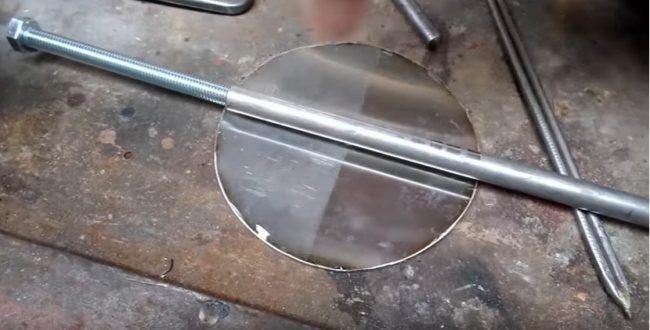
- The pipe is cut with a grinder. The inner hole is reamed for threading. While drilling, it is required to periodically lubricate the inside of the tube surface with machine oil.

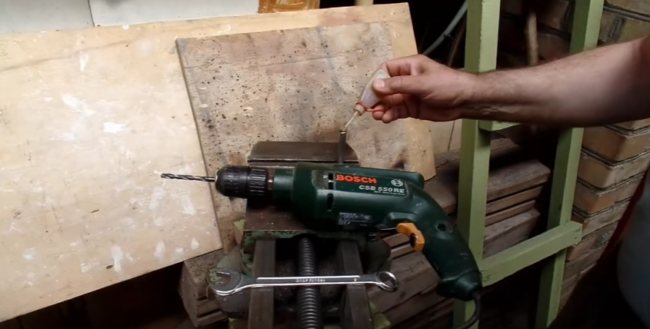
- An 8 mm thread is cut from both sides of the tube using a tap. During operation, the tool is constantly lubricated. To remove the cut chips, after each half-turn along the thread, you need to make a half-turn back in order for the chips to come out.

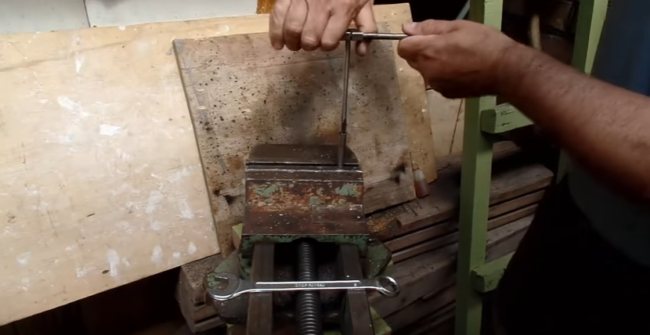
- Further, three small holes are made in the valve. Make three marks in advance with a marker.
- The tube and valve are clamped in the clamp, after which it is welded to the plate through these holes. Welding starts from the central hole of the future gate valve, after which one clamp is released and welded into the remaining hole.

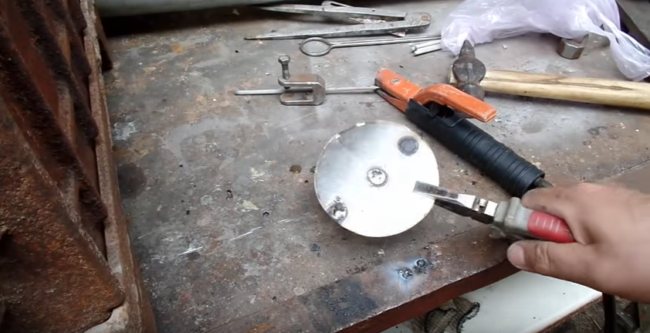
- Two holes are marked on the chimney. They must match on both sides for the tube to pass freely through them. To do this correctly, you need to wrap the pipe with a tape measure and measure the center vertically and horizontally. It remains to drill these holes.

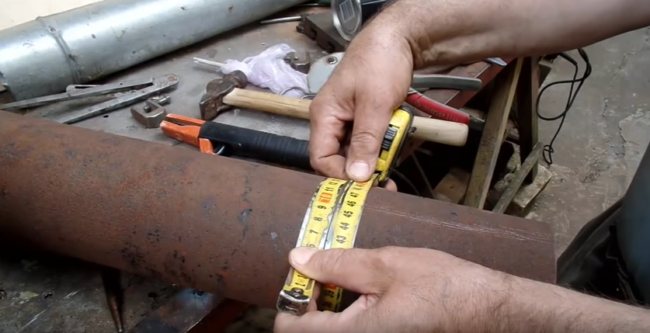
- The valve is assembled in the tube.


- Now we need to make a template for the retainer of our gate valve.


- The markup is transferred to a stainless steel sheet. A compass is used for this purpose.


- The middle for the holes of the retainer is marked, everything is cut and drilled according to the marking.
- It remains to weld the finished clamp to the pipe.


That's all, the chimney damper is ready. Although this option is more complicated, but with visual instructions and suitable photos, everything becomes easier.

